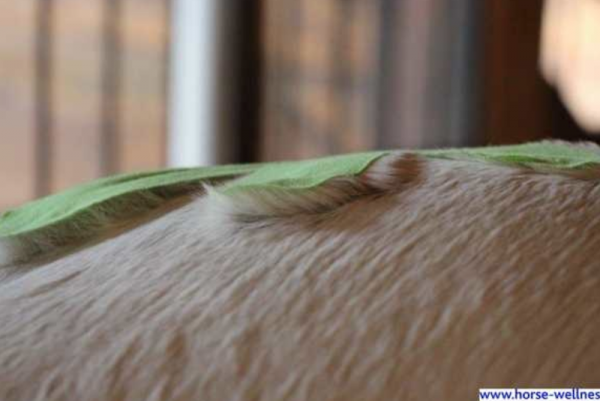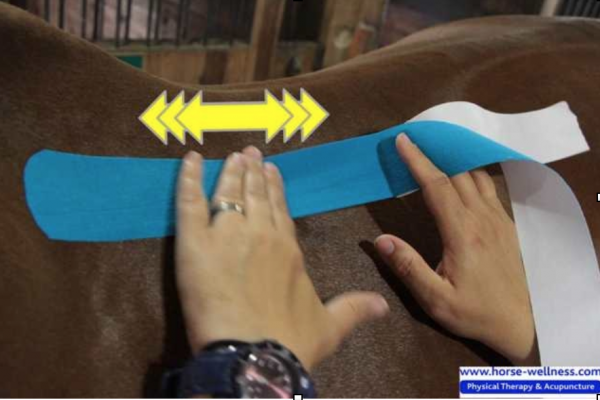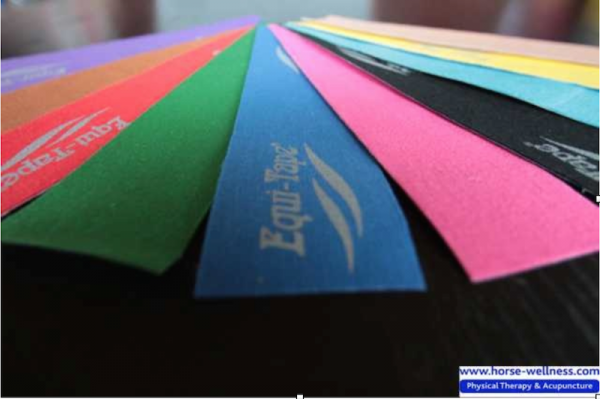Have you ever seen athletes covered in colorful tape and wondered what it is? How about on horses? It’s called kinesiology tape, and it’s a growing trend in the horse world.
First things first, what is kinesiology? It is the scientific study of movement, and that is exactly what this tape is for: supporting and promoting movement.
Taping methods have been out there for years, but in the past, the tape was made out of a sturdy, thick material that restricted movement. As the study of movement and biomechanics evolved, scientists and doctors realized that controlled movement is often better for the healing process than motion restriction. This is where kinesiology taping comes in. The tape was developed in the 1980’s by a Japanese chiropractor looking for a material that would provide support to the tissue but allow for range of motion.

What’s special about this kind of taping material?
It is a latex-free, cotton fabric with elastic fibers, which make it stretchable. On the backside is a medication-free adhesive that is applied in a very specific wave pattern, which allows air and fluid exchange.

How does it work?
Because it’s elastic and stretchable, kinesiology tape interacts with the skin, impacting the affected area’s pain, neuro and mechano receptors and decompressing the tissue.
That basically means that kinesiology tape lifts the outer layer of the skin, creating more space for the tissue underneath. This allows blood and lymphatic fluid to flow more easily in a specific area. This “lifting” effect then continues in the next layer of tissue, then the next, and so on.
Decompressing the tissue in this manner supports muscle activity because it washes out waste products allows new nutrients and oxygen to be transported to that area. It also takes away pressure from the pain receptors and therefore helps to reduce pain. Improving fluid circulation in an affected area can also activate the circulatory system, which speeds healing.

Because it proved so successful in human rehabilitation, training and prevention, kinesiology tape and other taping techniques have been adapted for use on horses as well, with some minor differences. Kinesiology tape on horses endures more than on humans because it must adhere to hair and is exposed to a lot of dust and dirt. So a stronger, better adhesive and customized application techniques had to be developed.
Most common taping applications for horses
Muscle taping

Depending on the direction of the taping you can either support and activate a muscle in training or rehabilitation, or you can relax a muscle that is very sore and tight.
Lymphatic taping

This promotes the circulation and is helpful for all kinds of swellings. It can even help relieve cellulitis (an infection that occurs in tissue underneath the skin and aggravates swelling) after the acute swelling phase is over.
Tendon and Suspensory taping

This is useful for horses recovering from a deep digital flexor tendon injury. It can also be done to support a weak fetlock and a strained suspensory ligament.
Scar taping

Scar tissue can be very rigid and sturdy and therefore block the energy flow and/or the range of motion in a horse. This product helps restore circulation to the area.
Hematoma taping

This also promotes circulation and helps decompress bruising.
Stabilization taping

Can be used after an adjustment or if there is a general weak spot or weak joint to prevent over-extension or re-injury.
Space taping

Creates the most space in the tissue and is used for trigger points.
Fascia taping

The fascia is a band or sheet of connective tissue enclosing muscles (and organs) that allows the muscles to glide by each other smoothly. If the fascia gets tight it can affect the muscle activity.
Do the colors have an effect?
Technically, no. Kinesiology tapes have the same design and material no matter their color. If you subscribe to color therapy, color can have a beneficial psychological effect. After years of experience with kinesiology tape I personally believe that color does have an influence.

How long are the applications supposed to stay on?
As long as possible, which with horses can be difficult as they tend to roll in the dirt, dust and mud. Some horses might nibble on their tape. Additionally, sweat can loosen the adhesive. Sometimes it stays on for a day and sometimes for weeks, it just depends on the horse and the situation. The general recommendation is no longer than 10 days.

Bottom Line
Kinesiology taping is not a magical solution to your horse’s injuries, but it can be a cost effective, non-invasive way to help ease their healing process. Be sure to consult an expert about the proper way to apply it to your horse before trying it for the first time. If you also suffer muscle aches or joint pain, you might considering trying the human version of kinesiology tape for yourself. Just make sure you and your horse color coordinate.
About the author
Katja Bredlau-Morich is a certified equine physical therapist. A native of Germany, she now owns and operates Horse-Wellness Equine Physical Therapy in Waltham, MA. Find out more about her program at www.horse-wellness.com.



 May 11, 2016
May 11, 2016 





















